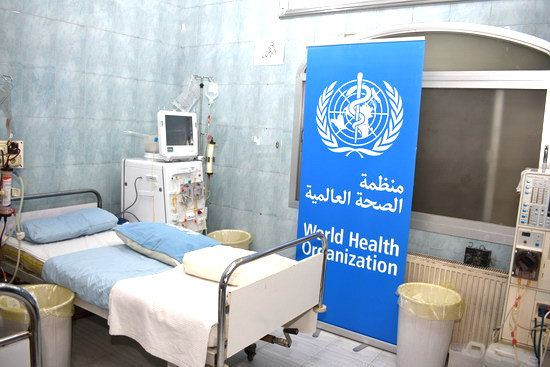Due to improved access to areas regained by the Syrian government, over half of public hospitals were functioning in 2019, albeit many of them at minimum capacity and with severe shortages of staff, medicines and supplies3. Hospitals in Aleppo, Dar’a, Homs, Idleb, Rural Damascus and northeast Syria were some of the worst affected. WHO delivered more than 230 pieces of medical equipment4 to over 60 hospitals in areas under government control and trained staff in 38 hospitals on neonatal resuscitation. Some 100 hospitals and health facilities in 12 governorates received intravenous fluids, NCD medicines and other supplies. The Organization assessed the status of the national cancer registry in five oncology facilities in Aleppo, As-Sweida, Damascus and Lattakia, and completed a study of the care experiences of cancer patients and their families. It also delivered cancer medicines and diagnostic equipment to the Ministry of Health (MoH) and one NGO and supported 15 287 referrals. The Essential Medicines List was updated in close collaboration with the MoH.

WHO’s office in Damascus supported training for more 2100 health workers from different governorates on topics including the rational use of medicines, pharmacovigilance, patient safety, IPC and supply chain management. A total of 255 female and male civil and biomedical engineers were trained on standard hospital design and rehabilitation, as well as the installation and maintenance of advanced medical equipment. In northwest Syria, WHO trained 210 health professionals on IPC, 40 obstetricians and midwives on neonatal care, 92 technicians on anaesthesia and 35 health care workers on burn management.
Almost three quarters of all health facilities in the northwest have been established since the crisis began in 2011. In late 2019, an assessment of health facilities in Idleb governorate found that, despite poor infrastructure and low capacity, 25 secondary health care facilities (including seven hospitals) were serving a population of 1.6 million, exceeding the minimum humanitarian standards of one hospital per 250 000 people.
Nonetheless, the hospital bed ratio was very low: 3.3 per 10 000 people compared with a pre-conflict rate of 15 per 10 000 people.
Major secondary health care gaps persisted throughout northwest Syria. Hospitals lacked specialized services for patients with cancer and kidney diseases. Trauma patients often occupied the few available beds in intensive care units. In many hospitals, equipment to support orthopaedic and reconstructive surgery was outdated or malfunctioning. Working from Turkey, WHO provided 662 000 treatments for intensive care units, dialysis sessions and chemical attacks and distributed essential medicines, supplies and equipment to seven major referral hospitals. It also supported two projects in 18 general hospitals and 24 intensive care units to improve the quality of care for NCD patients.








